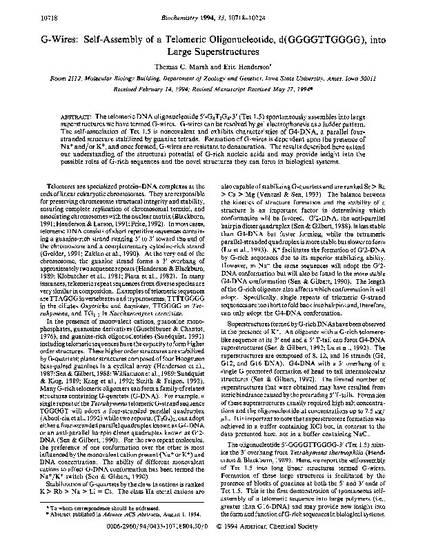
Article
G-Wires: Self-Assembly of a Telomeric Oligonucleotide, d(GGGGTTGGGG), into Large Superstructures
Biochemistry
Document Type
Article
Disciplines
Publication Version
Published Version
Publication Date
9-1-1994
DOI
10.1021/bi00201a020
Abstract
The telomeric DNA oligonucleotide 5’-G4T~G4-3’ (Tet 1.5) spontaneously assembles into large superstructures we have termed G-wires. G-wires can be resolved by gel electrophoresis as a ladder pattern. The self-association of Tet 1.5 is noncovalent and exhibits characteristics of G4-DNA, a parallel fourstranded structure stabilized by guanine tetrads. Formation of G-wires is dependent upon the presence of Na+ and/or K+, and once formed, G-wires are resistant to denaturation. The results described here extend our understanding of the structural potential of G-rich nucleic acids and may provide insight into the possible roles of G-rich sequences and the novel structures they can form in biological systems.
Copyright Owner
American Chemical Society
Copyright Date
1994
Language
en
File Format
application/pdf
Citation Information
Thomas G. Marsh and Eric Henderson. "G-Wires: Self-Assembly of a Telomeric Oligonucleotide, d(GGGGTTGGGG), into Large Superstructures" Biochemistry Vol. 33 Iss. 35 (1994) p. 10718 - 10724 Available at: http://works.bepress.com/eric-henderson/23/

Reprinted (adapted) with permission from G-Wires: Self-Assembly of a Telomeric Oligonucleotide, d(GGGGTTGGGG), into Large Superstructures. Thomas C. Marsh and Eric Henderson Biochemistry 1994 33 (35), 10718-10724. DOI: 10.1021/bi00201a020. Copyright 1994 American Chemical Society.